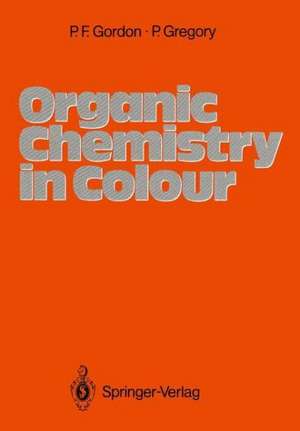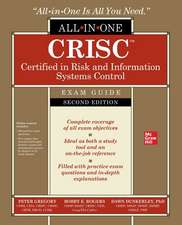Organic Chemistry in Colour: Springer Study Edition
Autor Paul Francis Gordon, Peter Gregoryen Limba Engleză Paperback – dec 1986
Din seria Springer Study Edition
-
 Preț: 386.26 lei
Preț: 386.26 lei -
 Preț: 370.79 lei
Preț: 370.79 lei -
 Preț: 296.06 lei
Preț: 296.06 lei -
 Preț: 403.37 lei
Preț: 403.37 lei -
 Preț: 508.91 lei
Preț: 508.91 lei - 23%
 Preț: 921.30 lei
Preț: 921.30 lei -
 Preț: 403.37 lei
Preț: 403.37 lei -
 Preț: 389.70 lei
Preț: 389.70 lei - 15%
 Preț: 502.73 lei
Preț: 502.73 lei -
 Preț: 389.70 lei
Preț: 389.70 lei - 5%
 Preț: 1122.94 lei
Preț: 1122.94 lei - 5%
 Preț: 370.38 lei
Preț: 370.38 lei -
 Preț: 406.25 lei
Preț: 406.25 lei - 15%
 Preț: 530.58 lei
Preț: 530.58 lei -
 Preț: 398.35 lei
Preț: 398.35 lei - 5%
 Preț: 368.73 lei
Preț: 368.73 lei - 15%
 Preț: 633.02 lei
Preț: 633.02 lei -
 Preț: 392.75 lei
Preț: 392.75 lei - 15%
 Preț: 588.69 lei
Preț: 588.69 lei - 20%
 Preț: 660.99 lei
Preț: 660.99 lei - 20%
 Preț: 663.61 lei
Preț: 663.61 lei - 15%
 Preț: 640.88 lei
Preț: 640.88 lei - 15%
 Preț: 654.43 lei
Preț: 654.43 lei -
 Preț: 390.46 lei
Preț: 390.46 lei - 15%
 Preț: 652.81 lei
Preț: 652.81 lei - 15%
 Preț: 642.03 lei
Preț: 642.03 lei - 15%
 Preț: 688.99 lei
Preț: 688.99 lei - 15%
 Preț: 642.36 lei
Preț: 642.36 lei - 15%
 Preț: 635.15 lei
Preț: 635.15 lei -
 Preț: 396.62 lei
Preț: 396.62 lei - 18%
 Preț: 893.21 lei
Preț: 893.21 lei -
 Preț: 419.14 lei
Preț: 419.14 lei -
 Preț: 423.34 lei
Preț: 423.34 lei - 20%
 Preț: 377.27 lei
Preț: 377.27 lei - 18%
 Preț: 742.97 lei
Preț: 742.97 lei - 15%
 Preț: 655.27 lei
Preț: 655.27 lei - 20%
 Preț: 336.02 lei
Preț: 336.02 lei -
 Preț: 397.38 lei
Preț: 397.38 lei
Preț: 394.87 lei
Nou
Puncte Express: 592
Preț estimativ în valută:
75.58€ • 82.13$ • 63.53£
75.58€ • 82.13$ • 63.53£
Carte tipărită la comandă
Livrare economică 21 aprilie-05 mai
Preluare comenzi: 021 569.72.76
Specificații
ISBN-13: 9783540172604
ISBN-10: 3540172602
Pagini: 340
Ilustrații: XI, 322 p.
Dimensiuni: 170 x 244 x 18 mm
Greutate: 0.58 kg
Ediția:1987
Editura: Springer Berlin, Heidelberg
Colecția Springer
Seria Springer Study Edition
Locul publicării:Berlin, Heidelberg, Germany
ISBN-10: 3540172602
Pagini: 340
Ilustrații: XI, 322 p.
Dimensiuni: 170 x 244 x 18 mm
Greutate: 0.58 kg
Ediția:1987
Editura: Springer Berlin, Heidelberg
Colecția Springer
Seria Springer Study Edition
Locul publicării:Berlin, Heidelberg, Germany
Public țintă
GraduateCuprins
1 The Development of Dyes.- 1.1 Introduction.- 1.2 Pre-Perkin Era — The Natural Dyes.- 1.3 Perkin and Beyond — The Synthetic Dyes.- 1.4 Future Trends.- 1.5 Summary.- 1.6 Bibliography.- 2 Classification and Synthesis of Dyes.- 2.1 Introduction.- 2.2 Classification of Dyes.- 2.3 Synthesis of Dye Intermediates.- 2.4 Synthesis of Dyes.- 2.5 Summary.- 2.6 Bibliography.- 3 Azo Dyes.- 3.1 Introduction.- 3.2 Basic Structure of Azo Dyes.- 3.3 Tautomerism.- 3.4 Metal Complex Azo Dyes.- 3.5 Colour and Constitution.- 3.6 Summary.- 3.7 Bibliography.- 4 Anthraquinone Dyes.- 4.1 Introduction.- 4.2 Structure of Anthraquinone Dyes.- 4.3 Tautomerism.- 4.4 Protonated and Ionised Anthraquinone Dyes.- 4.5 Metal Complexed Anthraquinone Dyes.- 4.6 Colour and Constitution.- 4.7 Summary.- 4.8 Bibliography.- 5 Miscellaneous Dyes.- 5.1 Introduction.- 5.2 Vat Dyes.- 5.3 Indigoid Dyes.- 5.4 The Phthalocyanines.- 5.5 Polymethine Dyes.- 5.6 Di- and Tri-aryl Carbonium Dyes and their Derivatives.- 5.7 Nitro (and Nitroso) Dyes.- 5.8 Summary.- 5.9 Bibliography.- 6 Application and Fastness Properties of Dyes.- 6.1 Introduction.- 6.2 Textile Fibres — Types and Structures.- 6.3 Application and Wet Fastness of Dyes.- 6.4 Light Fastness of Dyes.- 6.5 Photochromism.- 6.6 Heat Fastness of Dyes.- 6.7 Bleach Fastness of Dyes.- 6.8 Metamerism.- 6.9 Solvatochromism.- 6.10 Summary.- 6.11 Bibliography.- Appendix I.- Appendix II.- Author Index.






















